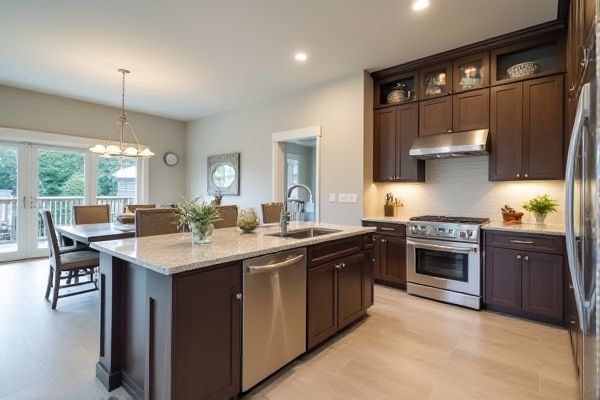
Laminate counters offer an affordable and versatile option with a wide range of designs, while stone counters provide durability and a natural, high-end aesthetic that can increase home value. Discover the key differences to help you decide which countertop material best suits Your kitchen needs by reading the rest of the article.
Table of Comparison
| Feature | Laminate Counters | Stone Counters |
|---|---|---|
| Material | Composite layers with plastic finish | Natural stone (granite, marble, quartz) |
| Cost | Low to moderate ($10-$40 per sq ft) | High ($50-$200 per sq ft) |
| Durability | Moderate, prone to scratches and heat damage | Highly durable, heat and scratch resistant |
| Maintenance | Easy, requires mild cleaning | Requires sealing, regular cleaning with stone-safe products |
| Appearance | Wide variety of colors and patterns, can mimic stone | Unique natural patterns, elegant look |
| Installation | Lightweight, easier and faster installation | Heavy, requires professional installation |
| Lifespan | 5-15 years | 25+ years with proper care |
| Resale Value | Minimal impact | Increases home value |
Introduction to Laminate and Stone Counters
Laminate counters feature a durable, layered construction with a decorative surface that mimics wood, stone, or other materials, offering an affordable and versatile option for kitchen and bathroom surfaces. Stone counters, such as granite, marble, or quartz, provide natural beauty, exceptional durability, and heat resistance, often increasing the value of your home. Choosing between laminate and stone counters depends on your budget, style preference, and the level of maintenance you're willing to commit to for your countertops.
Material Composition: Laminate vs Stone
Laminate counters consist of a synthetic plastic surface bonded to particleboard or fiberboard, offering affordability and a wide range of design options. Stone counters, such as granite or quartz, are made from natural or engineered stone, providing superior durability, heat resistance, and unique natural patterns. Your choice between laminate and stone counters depends on the balance you seek between budget, maintenance, and aesthetic appeal.
Aesthetic Appeal and Design Options
Laminate counters offer a wide range of vibrant colors and patterns, making them highly customizable to fit diverse interior styles, while stone counters such as granite or quartz provide a natural, timeless aesthetic with unique veining and textures that enhance sophistication. Stone surfaces often convey a sense of luxury and permanence, complementing upscale kitchens and bathrooms with their durable, polished finish. Your choice between laminate and stone counters will depend on whether you prioritize versatile design options or the elegant, natural beauty of genuine stone.
Durability and Longevity Comparison
Laminate counters offer reasonable durability but are prone to scratches, burns, and moisture damage, typically lasting 10-20 years with proper care. Stone counters, such as granite or quartz, provide exceptional durability, resisting heat, scratches, and stains while lasting 25-50 years or more with minimal maintenance. Your choice should consider the balance between cost, maintenance, and how long you want your countertops to maintain their aesthetic and functionality in demanding environments.
Maintenance and Cleaning Requirements
Laminate counters demand minimal maintenance, requiring only regular wiping with mild detergent and water to prevent stains and scratches. Stone counters, such as granite or quartz, need periodic sealing to protect against stains and avoid damage from acidic substances, making cleaning more intensive. Your choice depends on how much time you want to invest in upkeep and if you prefer a more durable but higher-maintenance surface or an affordable, low-maintenance option.
Cost Analysis: Budget vs Investment
Laminate counters offer a budget-friendly option with costs typically ranging from $10 to $40 per square foot, making them ideal for cost-conscious renovations or temporary solutions. Stone counters, such as granite or quartz, demand a higher upfront investment between $50 and $150 per square foot but provide long-term durability and added home value. Your choice depends on balancing immediate budget constraints against the potential return on investment from stone's enhanced aesthetic and longevity.
Installation Process and Complexity
Laminate counters offer a straightforward installation process, often completed within a few hours by homeowners or professionals due to their lightweight and flexible nature. Stone counters, such as granite or quartz, require precise measurements, heavy equipment, and skilled labor for cutting and fitting, resulting in longer installation times and increased complexity. Professional installation is essential for stone counters to ensure proper sealing and structural support, which protects durability and aesthetic quality.
Resistance to Heat, Stains, and Scratches
Laminate counters offer moderate resistance to heat, stains, and scratches but can be easily damaged by high temperatures and sharp objects, making them less durable compared to stone counters. Stone counters, such as granite and quartz, provide superior resistance to heat, stains, and scratches due to their dense, non-porous surfaces and natural hardness. The advanced sealing properties of stone countertops ensure long-lasting durability and minimal maintenance in high-use kitchen environments.
Environmental Impact and Sustainability
Laminate counters typically have a lower initial environmental impact due to their use of composite wood products and less energy-intensive manufacturing processes, but they often contain synthetic resins and plastics that can off-gas volatile organic compounds (VOCs). Stone counters, such as granite or quartz, offer greater longevity and durability, reducing the need for replacement and waste, yet their extraction and processing involve significant energy consumption and landscape disruption. Choosing recycled or locally sourced stone materials and low-VOC laminates can enhance sustainability by minimizing carbon footprint and chemical emissions.
Pros and Cons: Laminate vs Stone Counters
Laminate counters offer affordability, a wide variety of designs, and ease of installation, but they are prone to scratches, heat damage, and have a shorter lifespan compared to stone. Stone counters, such as granite or quartz, provide superior durability, heat resistance, and a luxurious aesthetic, yet they come with a higher cost and require professional installation. While laminate suits budget-conscious renovations with moderate use, stone counters are ideal for long-term investment and heavy kitchen activity.
 homyna.com
homyna.com